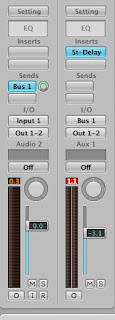
Last year for one of my band's tours, I released a CD of old, unreleased songs from before I was signed. Because the originals sounded pretty bad by today's standards, I decided to re-record them since I had all the original equipment and sequence discs. It was fun, but it was also one of the most challenging things I've done as a lot of these tracks were done with very lo-fi samples (my sampler only had 2 megs of memory) and it was tough making them sound presentable. Today I finished mixing a second volume of early tracks that I hope to put out next month.
One of the problems I had was that my sampler, an old Ensoniq EPS-16+ only sampled in mono. With some of the sounds, such as strings and pads, the impact the sounds could've had is kind of lost this way. Not to worry, however, as a little stereo ping-pong delay can remedy that pretty nicely. I'll be going through this exercise in Apple Logic Studio
1. Select the track that has the string or pad sound on it you want to 'embiggen' (apologies to Jebediah Springfield...). In the channel's first send slot, select Bus 1 and crank the send level to its maximum value.
2. Find the send you just assigned on your mixer (on Logic's arrange page, this should come up right next to your string channel when you assigned the bus... just like in the picture above) and in the insert slot of that send, choose Logic's Stereo Delay plug-in. Logic defaults to a ping-pong style delay with this plug-in, so if you're using a different host/plug-in, be sure to set your stereo delay up to a ping-pong setting (one that bounces back and forth in stereo).
3. Now play your sound and notice how much bigger and lusher it sounds! Here's a quick example using a grimey, lo-fi string sample from my EPS. The first part is the sound dry, and the second is the 'widescreen' version (obviously this is only going to be noticeable if you're listening to this through proper speakers and not your computer's built-in sound):
This generally works best for sounds with a slow attack such as strings or slow synth pad sounds, as the individual echoes of the delay are 'smeared' a bit and are not very noticeable in the context of the mix. Isolated, you can still hear the delays, but in a mix this works just fine. And while the difference is most noticeable with mono material, it will work on stereo tracks too.




















3 comments:
This pseudo stereo effect doesn't do much for me because the wideness comes in after the initial attack and, for to my ear, works emphasizes the initial mono-ness.
When I want to make something stereo (or really fake multiple takes), I go about by using the Sample Dealy plugin and offsetting one side by somewhere between 100 and 400ms usually. I know this isn't as fancy as the Stereo Delay but, in the context of a mix and mixing, I find that this sits better and sounds better in the end product.
Just my 2 cents.
Yes, this is why I mentioned that this is an effect that works in the context of the mix better than in an isolated setting.
Sorry to be posting to such old articles, but this is a great tip! I've been doing this sort of thing in Reason for many years, but could never figure out how to work the routing in Logic to replicate the effect. It seems pretty obvious now, but it's frustrated me for a long time. Thanks!
Post a Comment